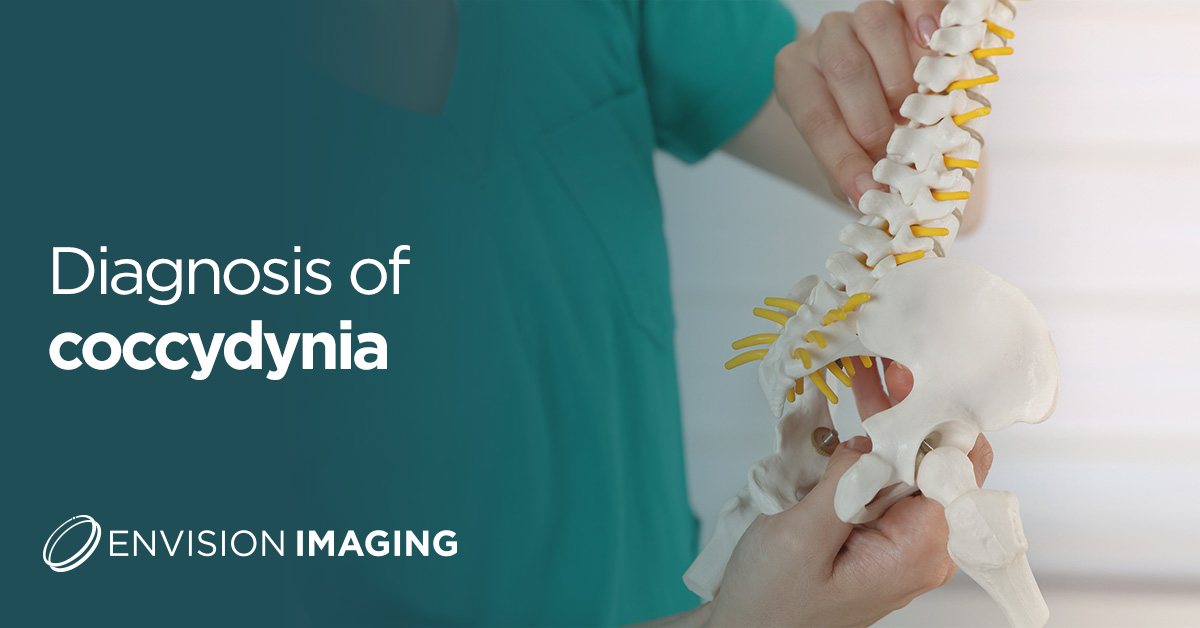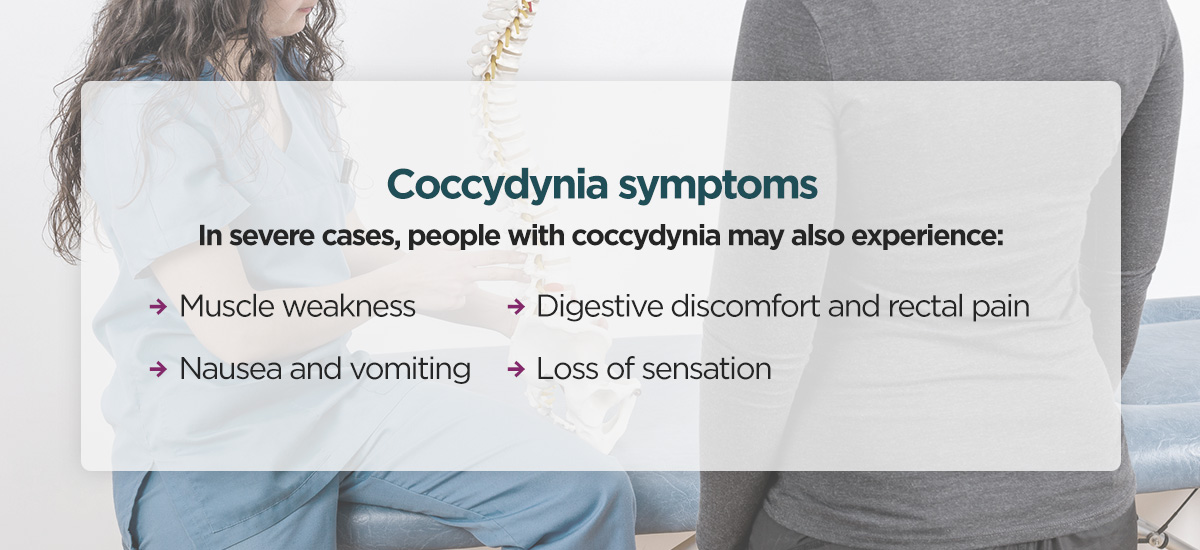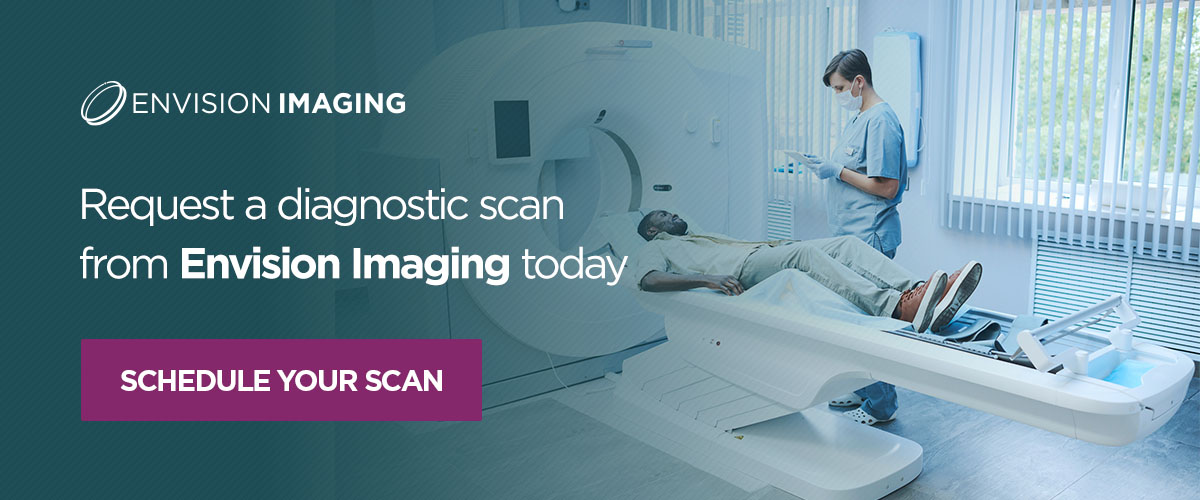Diagnosis of Coccydynia

Coccydynia can interfere with sleep, exercise and even the simple act of sitting. Fortunately, the proper home care techniques and professional treatments can ease or eliminate the pain.
If you experience consistent pain in your tailbone, read on to discover what may be causing this discomfort, as well as different treatment options you can pursue.
What is coccydynia?
Coccydynia is a term for tailbone pain. Your tailbone — or coccyx — is a small, triangular bone at the base of your spinal column directly above the buttocks.
Your coccyx lies below the sacrum, a shield-shaped bone structure at the spinal base that attaches to the pelvis. Several muscles, tendons and ligaments connect to the sacrum. The coccyx and pelvis help support your weight when you sit down.
Two-thirds of adults have a slightly curved coccyx instead of one that points downward — however, a tailbone that curves too far down can be painful.
Coccydynia can last anywhere from weeks to months or longer. The pain can range from a mild ache to a sharp stab.
Tailbone pain causes
Tailbone pain can develop gradually without a clear cause, or it can emerge abruptly following an injury. Some specific causes of coccydynia include:
- Pregnancy and childbirth: Near the end of pregnancy, the body releases hormones that soften the area between the coccyx and sacrum, allowing the coccyx to move more freely during childbirth. While this movement is natural, it can stretch the coccyx ligaments and muscles excessively, elevating the pain. When strained, these soft tissues can’t support the coccyx at the proper angle.
- Physical injury: Knocks, falls, childbirth trauma and other physical damage to the coccyx can lead to pain and discomfort. Severe falls can cause bruising, fracturing and dislocation.
- Infections and tumors: Infection or cancer in the spine or surrounding tissue can result in tailbone pain.
- Weight: Obesity can put additional pressure on the coccyx, causing it to lean backward. This abnormal position can become increasingly painful over time. Being underweight may also stimulate tailbone pain in some cases. Without sufficient fat in the buttocks to keep the coccyx from rubbing against the tendons, ligaments and muscles, the soft tissues can become inflamed.
- Prolonged or unsupported sitting: Sitting may contribute to tailbone pain, especially if you sit on a narrow or hard surface for extended durations. Try to get up often, take a brief walk and do some stretches. Consider finding a softer, comfier place to sit, like a cushioned chair.
- Repetitive Strain Injury (RSI): Activities that involve repetitive leaning and stretching of the spine — like rowing and cycling — can strain the soft tissues around the tailbone.
Coccydynia most frequently affects adults and adolescents, obese individuals and women. Females are five times more likely to experience coccyx pain than males, especially with childbirth-related injuries being a significant factor.
Coccydynia symptoms
Coccyx pain can feel different for everyone. One might experience a dull, throbbing ache resembling a muscle spasm, while another might have sharp, stabbing sensations. In severe cases, people with coccydynia may also experience the following symptoms:
- Muscle weakness
- Nausea and vomiting
- Digestive discomfort and rectal pain
- Loss of sensation
When to seek medical care
Coccyx pain doesn’t typically warrant serious concern. However, you should seek treatment if your pain stems from a sudden trauma and you have extensive bruising, a loss of sensation, tingling in surrounding areas, and changes in coordination or movement.
If you experience tailbone pain without an apparent physical injury, it could be from an underlying condition. You should seek medical assistance when:
- Your tailbone pain doesn’t resolve after a couple of weeks.
- Your chronic pain improves, then returns.
- The pain persists or worsens despite home treatment.
- Unexplained symptoms accompany your coccyx pain.
- You have a fever.
How doctors diagnose coccydynia
When diagnosing coccydynia, your doctor will perform a comprehensive assessment, including a physical exam and review of your medical history. They may ask you about:
- Any history of gastrointestinal issues.
- A recent fall, accident or other trauma that caused coccyx pain.
- Previous childbirth and pregnancy experiences.
- Any other muscle- or nerve-related problems.
After evaluating your medical history and symptoms, your healthcare provider can proceed with the appropriate testing method. This might include:
- A rectal exam to determine if an issue with these muscles is causing coccyx pain.
- A pelvic exam to assess your pelvic floor strength.
- A magnetic resonance imaging (MRI) or computed tomography (CT) scan if your doctor suspects a separate bone, tissue or nerve problem is causing tailbone pain.
- An x-ray to check for a fracture.
- Blood tests to rule out autoimmune conditions or infection.
Coccydynia treatment options
Coccydynia treatment usually starts with noninvasive home care methods, such as:
- A cold or hot compress: Applying a heating pad or ice pack to the tailbone region may provide immediate temporary relief.
- Rest: Like with any other injury, rest is vital for recovery and helps avoid further tailbone injury.
- Extra cushioning: A donut- or wedge-shaped cushion offers additional padding to minimize pressure on your coccyx while sitting. These cushions are widely available at retail pharmacies.
- Avoiding extended sitting: This can help prevent increased pain and injury.
If you still deal with coccyx pain after trying these self-care strategies, your healthcare provider may recommend one or more of these treatments:
- Physical therapy: A physical therapist can recommend stretches that strengthen the tailbone muscles. They’ll also suggest movements and sitting positions that better support the coccyx and pelvic floor.
- Injectable medications: Your doctor may use injectable steroids to help ease coccyx pain. This can also help reduce muscle tension during physical therapy.
- Pain medication: Your doctor may recommend over-the-counter or prescription medications to alleviate pain.
- Surgery: If your pain doesn’t improve with nonsurgical remedies, a coccygectomy may be necessary. This procedure removes the coccyx either partially or completely. It can help address physical damage like a herniated disc or pelvic floor relapse. However, it’s a rare procedure and should only be pursued as a last resort.
Request a diagnostic scan from Envision Imaging today
If you experience persistent coccyx pain, diagnostic imaging may be in order. At Envision Imaging, we specialize in world-class radiology services, including MRIs, x-rays, CT scans and more. Combining accurate results with compassionate, personalized care, we aim to provide every patient with superior service and a pleasant experience.
Whatever your condition, unique needs or imaging procedure you require, our proficient staff and state-of-the-art equipment can help you begin your road to tailbone pain recovery. Because we strive to provide both exceptional and affordable care, we accommodate a wide range of insurance plans. We also offer thorough education for those who wish to learn more about our imaging services.
Don’t let coccydynia put your life and activities on hold. Request an x-ray or a screening mammogram from our team today!
Browse our locations to request your next diagnostic imaging appointment. Our world-class facilities, compassionate care and accurate results ensure a pleasant and reliable experience.




